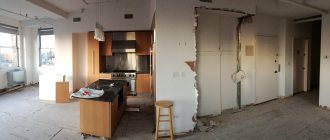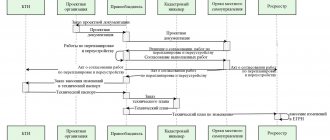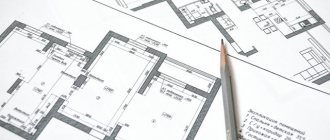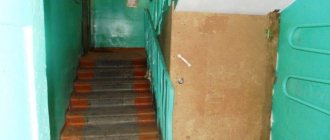In Art. 25 of the Housing Code of the Russian Federation defines what is the refurbishment of an apartment, what is its redevelopment.
Redevelopment of an apartment implies a change in its configuration , which is reflected in the technical plan of the apartment; in other words, these are changes that entail amendments to the layout of the premises, which is available in the BTI. Demolition of walls and partitions, their relocation, combining premises, increasing living space due to auxiliary premises, arranging a new opening while filling in the old one - all work of this nature is a redevelopment and entails corresponding consequences.
Dear readers! Our articles talk about typical ways to resolve legal issues, but each case is unique. If you want to find out how to solve your particular problem, please use the online consultant form on the right or call. It's fast and free!
Basic requirements for redevelopment of an apartment: it must be safe, completed in compliance with the requirements of sanitary and building codes, as well as other applicable regulatory documents, and must not violate the rights of other residents of the house.
Redevelopment of an apartment should be distinguished from refurbishment (refurbishment of premises).
Re-equipment includes any work related to the replacement or transfer of equipment installed in the premises : electrical, gas, plumbing. For example:
- Relocation of radiators and geysers;
- Replacing a gas stove with an electric stove and vice versa;
- Re-equipment of sanitary facilities, for example, replacing a sink, toilet, bathtub or shower cabin, bidet, except in cases where the new equipment does not differ in parameters and technical design from the previous one (that is, replacing an old bathtub with a similar new one does not require changes, but replacing a cast iron bathtub with a “jacuzzi” will be a refurbishment);
- Laying new electrical or water wiring, new gas pipes;
- Making changes to the floor structure: that is, if during the repair work not only the top covering was affected.
Remodeling may also include the installation of high-power appliances, such as an air conditioning system or washing machine.
Such changes, similar to redevelopment, will require adjustments to the inventory plan of the premises.
However, not all changes need to be registered; redevelopment does not include:
- Relocation or replacement of household appliances (washers, dryers, dishwashers, boilers);
- Moving floor-mounted household electric stoves within the kitchen;
- Replacement of the final floor covering;
- Glazing of balconies;
- Installation of a low-power household air conditioner;
- Cosmetic finishing of the room, in particular, replacement of the finishing coating of the ceiling, walls, floor, as well as replacement of external elements, if the design and color are preserved;
- Work on installation and dismantling of built-in furniture. It should be taken into account that built-in wardrobes may be reflected in the floor plan, which means the need to coordinate the disassembly or relocation of such furniture.
Simple apartment reconstruction
In the case where simple transformations of the premises take place, the redevelopment can be legalized after the repairs have been carried out, without obtaining prior permission for the redevelopment. But a condition must be met: such transformations must be insignificant. These types of changes include:
- Demolition and relocation of interior partitions (not load-bearing walls), as well as installation of openings in them. This rule does not apply to cases of moving or dismantling partitions between kitchen and living spaces;
- Construction of new partitions between rooms, if this does not entail an increase in the load on the floor;
- Elimination of doorways in walls of any type.
To carry out this work, a special project will not be required; you will only need to provide a sketch with the planned changes applied to the existing floor plan.
Repair with moving walls: from approval to acceptance
Moving walls is not only labor-intensive, but also requires a lot of paperwork. How to do it as quickly as possible and how does this procedure differ in different types of houses?
When renovating, moving walls is a fairly common practice. The procedure involves demolishing the old partition and building a new one, made of brick or plasterboard. This is done to expand the space of some rooms at the expense of others; turning walk-through rooms into separate ones; combining several rooms into one or, conversely, dividing a room into several. Moving walls makes the interior special and allows you to realize design ideas that cannot be implemented in standard layouts. Therefore, during a major renovation of an apartment, designers often include this type of work in the project. But we must also remember that redevelopment is not always possible and requires approval.
The need to legitimize redevelopment - how to legitimize an apartment redevelopment that has already been done
Unauthorized redevelopment is a serious obstacle to the exercise of property rights, which include: sale, donation, pledge of property, etc.
If an illegal redevelopment of an apartment is discovered (for example, in the event of an emergency, during an inspection, or as a result of denunciation by neighbors), the owner may face a significant fine. The redevelopment will have to be legalized within 3 months, otherwise the owner will be fined again. If the identified redevelopment was carried out in violation of the requirements, the owner will be obliged to return the premises to its original form and compensate for the damage caused to other residents. Failure to comply with this requirement will entail the sale of the apartment at auction, eviction and deprivation of ownership.
It should be remembered that significant intervention in the structure of a house without a technical report and a redevelopment project can cause the house to collapse or be declared unsafe.
How to transfer a drawing to a wall
Hello! I want to share with you one trick to easily and quickly transfer a drawing to a wall (or any other object). Now I am finishing up renovations in the bedroom, which still needs to be combined with an office. Since my workplace requires a lot of space, it was decided to divide the room into 2 zones and paint the walls in two colors, but in order not to leave a contrasting stripe between the colors, I decided to divide these 2 zones with a pattern. In order not to waste time and money on making a stencil, I decided that I would draw it myself, so as not to waste my art education))
We take an image we like, scan or download it in high resolution, and then print it at any printing center. (I drew the sketch on the computer in high resolution. The maximum size that they could print for me was 115 x 90 cm). It's smaller than the size I need, so I cut the printout into 2 pieces and spread it apart, then filled in the missing pieces.
ATTENTION: The lower the image quality, the more pixels will be visible!! (when printed, the outline of the drawing may “blur”, but that’s okay! We only need the printout as a “carbon copy”)
I decided to make the drawing on two walls, so I changed the image a little and printed two versions
The stripe in the drawing was made to make it easier to attach the drawing to the border of colors on the wall.
Next we will need:
— Soft material (sauce, sanguine, coal, chalk) — any of your choice
I chose the sauce (soft material), because I needed 2 shades: light and dark (since the walls are painted in 2 colors). You can buy soft material at any art store or arts and crafts store.
We turn our printed drawing over with the image facing down and on the reverse side we begin to shade the sheet with soft material.
(for convenience and accuracy, it is better to mark with a line the places where the drawing is located. You can attach the drawing to the window with the white side facing you and outline the location of the drawing with a line).
Shake off crumbs and dust from soft material
Using tape, attach the drawing to the wall. We stick tape in the corners. We try to touch the drawing itself as little as possible and move the sheet, because the chalk on the back side can leave a lot of marks on the wall.
Take a pen or pencil and trace the outline of the drawing. The harder you press on the pen, the clearer the design will be printed.
When the drawing is completely outlined, carefully peel off the tape and remove it from the wall.
This is what the drawing looks like
Now take a brush and paint and outline the outline with a thin layer.
It is important that the line is very clear and even.
Then we paint over our drawing with a thin layer.
Now we translate the lower part of the drawing and also, first we outline the outline, then we paint over the entire drawing
I had to get a little creative and draw the stems myself, because I cut the printed drawing so that it would fit the entire wall.
Now we outline the drawing on the second layer. First the outline, then everything else.
The end result is a wall like this
And on the opposite wall
When the paint is completely dry, wipe off the remaining sauce with a damp cloth.
Invalid changes
The law prohibits such changes as:
- Expansion of the kitchen space and/or sanitary unit into the living space by more than 25% of the original living area;
- If the kitchen is equipped with a gas stove, when combining the kitchen and living space, according to fire regulations, the actual result is an expanded kitchen, which, according to sanitary rules, cannot be located above the living space (here we are talking about the layout of the adjacent room located below). However, if the neighbors below carry out a similar redevelopment with adjustments to the inventory plan, this problem disappears. Another option for owners of a gas stove, which allows you to dismantle the wall completely or partially: install a sliding partition that will separate two rooms, while leaving the opportunity to open the space if necessary. If the apartment is one-room, combining the living space and kitchen with a gas stove is prohibited, since in this case the living space simply ceases to exist;
- Elimination of load-bearing structures. The solution in this situation would be partial dismantling of the wall or an opening in the wall. You must first carry out a technical inspection of the house, develop strengthening schemes, coordinate the work and obtain permission from the authorities. In the case when legalization occurs after the fact, all finishing coverings of the opening are opened so that the engineer has the opportunity to examine the condition of the supporting structures, the presence of reinforcements, etc.
- Reduction, transfer or dismantling of common building communications. This may include: ventilation openings and ducts of ventilation systems, water pipes, and in some cases, radiators of the heating system;
- Increasing the balcony space due to the area of the living room (however, it is allowed to construct an arch no more than 1 meter wide);
- Placing a kitchen or sanitary facilities (bathroom, toilet) above living spaces, placing bathrooms above kitchens. The only option that allows a bathroom to be placed above the kitchen is a two-level apartment;
- Equipment for heated floors powered from the general house network, placement of heating systems in cold rooms (balconies, loggias);
- Construction of a bathroom doorway (equipped with a toilet) leading directly to the living space. The exception is apartments where people with disabilities live;
- • Any work that entails difficulty in accessing general life support systems, deterioration of living conditions for citizens or violation of their rights, or reduction in the strength of the house structure.
What can and cannot be demolished?
Before approving remodeling repairs, make sure that supporting structures will not be affected. Dismantling them is dangerous not only because you may have problems with the BTI and housing inspection: you put the entire house and the people living in it at risk. Only a specialist can definitely answer the question of whether a wall is load-bearing, but in some cases you can determine this yourself:
- In “Khrushchev” apartments of all series, only the external walls are capital, and all internal interior walls are partitions.
- In houses made of concrete slabs, partitions can be identified visually by their relative position with the ceiling slabs: if the wall is located along them, then this is a partition, since the floor slabs lie on the main walls with their edges.
- In houses made of bricks and foam blocks, it is difficult to determine the load-bearing structures, and it would be better if a specialist does this.
If you are convinced that the wall is not permanent, you can move it. But only after agreement.
Procedure
In accordance with Art. 26 of the Housing Code of the Russian Federation, the owner has the right to carry out redevelopment and re-equipment of the premises after receiving the consent of the self-government bodies.
Legal redevelopment
1. Contact the BTI. You must have with you:
- Application for redevelopment;
- Applicant's passport;
- Documents confirming ownership.
2.Visit to the architecture department of the district administration. What documents are needed to redevelop an apartment:
- Application for home adjustment;
- Documents containing information on the procedure for obtaining property rights (certificate of inheritance, purchase and sale agreement, etc.);
- If the apartment is rented or transferred under a free use agreement: written consent of the owner of the premises and his family, certified by a notary;
- Written permission of adult citizens living in the apartment at the time of repairs, certified by the housing department or HOA;
- Consent of the management company;
- A copy of the financial and personal account received from the accounting department of the passport office;
- Technical passport from BTI;
- Extract from the apartment (house) register;
- Design documentation, depending on the planned work. In the case of a simple reconstruction - a sketch, a technical report and a redevelopment project - in case of planned changes to the load-bearing structures of the building. The sketch is a floor plan with planned changes marked on it: green – what is being built, red – what is being dismantled. Such a document does not require legal registration. The project is being developed in the city's architecture department with the participation of the chief architect. The technical report is drawn up by a technician from the BTI. You may need permission from Rospotrebsoyuz, the Ministry of Emergency Situations, the SES and the gas organization.
- If the apartment is located in a building that is an architectural monument, you should obtain a conclusion from the relevant authority, excluding any damage to the building;
- If the apartment was purchased under a mortgage lending program or was pledged during other transactions, the redevelopment must be agreed upon with the holder of the lien on the property.
To carry out redevelopment of an apartment, it is necessary to provide a technical passport to government authorities. What is a technical passport for an apartment and how to get it, read the materials at the link. The procedure for registration and validity of a cadastral passport for an apartment is in our new article.
3.Once you receive permission, you can begin work.
4. Approval of the changes made and drawing up a certificate of completion of work. For this purpose, it is necessary to invite a specialist from BTI who will take all measurements. Please note that changes in the project are indicated with an accuracy of 1 centimeter.
5. Obtaining permission from the administration to preserve housing in a modified version;
6.Adjustment of the technical package of documents. You must apply to the BTI for a new registration certificate, having with you:
- Sketch or project;
- Permission for redevelopment;
- Certificate of work performed.
7. When contacting the cadastral service directly or for an additional fee, without leaving the BTI, you must obtain the cadastral number of the apartment and building;
8. Registration of a cadastral passport: to do this, you should contact the Cadastral Chamber with all the completed documents, on the basis of which a cadastral passport for the changed housing will be provided;
9. Obtaining documents from Rosreestr confirming ownership of the reconstructed premises.
Types of redevelopment according to labor intensity
Redevelopment according to drawing
To directly approve the redevelopment according to the drawing, it is not necessary to prepare a full-scale plan. Manipulations belong to the category of harmless, therefore, they do not have a negative impact on capital structures.
This kind of redevelopment is considered:
- Connection between bathroom and toilet;
- Increasing the opening;
- Relocating a passage in a capital structure.
To approve the redevelopment in accordance with the sketch, the adjustments made should be listed on a duplicate of the BTI floor plan and delivered to the housing inspectorate.
Important! No prior permission is required to carry out the above work. You just need to make sure that the structure is not load-bearing.
When the planned manipulations with the door are made, the additions are displayed in a duplicate of the apartment plan. After which an application is submitted to accept the apartment after redevelopment.
How to independently legalize the redevelopment of an apartment
Redevelopment will be considered unauthorized if it was carried out before obtaining the appropriate permission. In this case, the owner, in addition to the Housing Code (Article 29), should be guided by the Code of Administrative Offenses (Article 7.21).
1. As in the case of legal redevelopment, after the work is completed, it is necessary to invite a specialist from the BTI who will validate the changes. The BTI must provide:
- Old registration certificate;
- Application for calling a technician;
- Certificate of entitlement;
- Identity document;
2. Obtaining a conclusion from the SES on compliance with standards;
3. Drawing up an order for the production of a technical project. To do this, you should contact the BTI or another design organization with authority;
Do you need an extract from the house register? Find out how to get an extract from the house register in our step-by-step instructions. Read about how to convert residential premises into non-residential ones and what documents are needed for this.
4.Receiving a referral to court from the district administration;
5.Litigation. List of documents for applying to court:
- Claim to preserve the redevelopment carried out;
- Title documents (originals and copies);
- Conclusion from the SES and the design organization;
- Two versions of the technical passport: original and with amendments;
- Consent of the residents of the apartment, as well as its owner, if the redevelopment was carried out by the tenant;
- If a building is recognized as a cultural or architectural monument, a conclusion is required that no damage was caused to the building.
6. In case of obtaining permission from the judicial authorities, it is necessary to complete a package of documents (personal documents, all consents, conclusions and permits received, documents on ownership). Then the owner proceeds in the same way with legal redevelopment: applying to the BTI, then to the Cadastral Chamber.
Cost of time and finances
- An initial application to the BTI will cost about 600 rubles and will take approximately two weeks;
- The applicant can obtain permission from the district administration within 45 days from the date of submission of documents;
- The financial costs of redevelopment will depend on the complexity of the work and the choice of materials. As for the timing, as a rule, about 4 months are allotted for this procedure;
- The redevelopment project will cost at least 2,000 rubles and will take one to two weeks;
- The fine for illegal redevelopment for citizens will be from 2 to 2.5 thousand rubles, in case of violations - up to 5 thousand rubles. For officials and legal entities the figures are more impressive - the amount of the fine can reach 300,000 rubles.
- A certificate of completion of work will be issued within 10 days from the date of taking the necessary measurements;
- Correcting the technical package of documents will cost at least 4,000 rubles;
- Obtaining approvals does not require financial costs if you apply to the authorities yourself; if you contact specialists, the amount will vary from 10,000 to 35,000 rubles;
- A new technical passport can be obtained within two weeks; on average, you will have to spend about 1,200 rubles;
- A new Cadastral passport is issued within five days from the date of submission of documents, the cost of the service for individuals is from 50 rubles.
Is it necessary to legalize the existing redevelopment of an apartment in 2021?
Making changes to the Unified State Register of Legal Entities (as a result of interdepartmental exchange of information or independently by preparing a technical plan).
It often happens that an apartment is first redesigned and then decorated. This is not always done consciously. This is a frequent case when, after a transaction, it turns out that the purchased apartment was illegally redeveloped. The possibility of such a situation arises due to the fact that currently it is not necessary to present a technical passport to complete a transaction.
How long will it take for approval?
The entire approval procedure takes about 2-3 months, of which most of the time will be spent on preparing the project and its approval:
- Preparation of a redevelopment project: from 1 week. Most often 1-2 months. Depends on the complexity of the work, the chosen company, the amount of payment and many other factors.
- Ordering a new extract from the Unified State Register of Real Estate: from 3 days.
- Coordination of redevelopment: up to 45 days.
- Obtaining permission for redevelopment: up to 3 days.
- Re-registration of a technical passport: from 1 week.
What redevelopment can be done without permission?
There is a certain list of works for remodeling an apartment, which does not require separate approval or legalization after completion of the renovation. Let's consider the types of redevelopments that do not require approval in more detail:
- Redecorating . It does not involve changing the area of the premises, any serious replacement of structural elements, and so on. Most often this is simply covering with plastic panels, replacing wallpaper, painting, plastering, and so on. All this does not require prior approval.
- Working with built-in furniture . In some apartments there is built-in furniture, which was provided by the developer and has been there ever since. Usually these are some kind of cabinets and pantries that take up extra space and are more of a nuisance than a help. All such objects can be easily disassembled. The opposite is also true. If a person wants to build such a closet-storage room for himself, then there are no prohibitions on this. The main thing is that it really is furniture, and not a separate room (it is not expected to erect partition walls, form additional doorways, and so on).
- Replacement of equipment . For example, heating radiators, stoves, pipes, boilers, and so on. It is important that the equipment to which the old one will be replaced had similar characteristics. At a minimum, it should be no worse in its effectiveness. Often, in order to combine the kitchen and living room, they change the gas stove to an electric one (combining kitchens in which gas equipment is installed with rooms is prohibited). The replacement of the stove itself in such a situation will not require separate approval, but work on combining the premises will.
- Replacement of floor coverings . The owner can install laminate instead of linoleum, replace the tiles on the bathroom floor and carry out other similar work. This also does not require approval. In practice, this element is often classified as cosmetic repairs, although in essence it is still more serious and complex work.
- Changing the purpose of the room . The owner of the apartment can decide for himself where he will have a living room, bedroom, office, and so on. He can renovate the bedroom into an office, but he cannot move the kitchen to another living space. To simplify, the owner can modify the residential rooms for their intended purpose as he pleases, but he cannot touch non-residential premises (bathroom, kitchen, balcony, loggia, etc.) without separate approval (and in some cases cannot touch in principle).
It should be taken into account that some regions of the Russian Federation have their own rules and peculiarities regarding redevelopment. To the point that they may require approval even for a simple replacement of windows (wooden to plastic, which usually refers to cosmetic repairs) or even the installation of an air conditioner.
How to make a partition - stages of work
So, here are step-by-step instructions on how to make a partition in an apartment:
- First, you need to mark the surface of the floor with a marker so that it will be convenient to subsequently install a structure made from the material of your choice.
- Then you should pick up a plumb line and chalked cord and transfer the resulting pattern to the ceiling and walls.
- To make the partition stronger and to prevent the sound of it swaying when walking, stick rubberized tape on the floor. It is easy to glue it to the profile itself so that extraneous sounds do not disturb you in the future.
- After this, it is worth attaching the profile and shelf along the planned frame. We use dowels.
- Next, it’s worth working using metal screws, since they fit well into the material we need - be it foam block or drywall.
- The profile you choose must be thick enough so that the screws do not come out and screw in normally. The metal should be about half a millimeter thick.
- You can strengthen the made partition with a wooden beam.
- The beam must be inserted into the profile and screwed to the metal surface using the above-mentioned screws.
- If necessary, taking into account the characteristics of the room, you can make windows to make it brighter. To do this, you need to retreat the required amount from the ceiling and strengthen the guide (horizontal). Here is the answer to the question of how to make a partition in an apartment from plasterboard with windows.
- To give the greatest stability, you need to insert vertical profiles into both the lower and upper slats. Step is about 35-45 cm.
- If necessary, you can make a frame for the window frame of the width you need.
- Now the finished frame can be sheathed with the selected material - plasterboard or foam block.
- If there are windows, it is necessary to cut holes for them in the attached material.
- However, you can also take care of heat and sound insulation. For the safest insulation, you can use a special material - mineral wool, which is lightweight and easy to use. Moreover, it is absolutely safe.
- After the inside of the frame is filled with insulating material, it can be sheathed with the selected material.
After reading all the points in the instructions, you will understand exactly how plasterboard partitions are made in an apartment, and subsequently get a strong partition. Not made of brick, but easier to install and further use.
How to make a partition for a one-room apartment is a very important question, especially when many people live in it. It will be easier here, since the structure will be stronger in a smaller space. Making a partition in a one-room apartment with your own hands is a task for an experienced home craftsman.
If there is no need for heat and sound insulation, then you can install sliding partitions - beautiful and inexpensive. The main thing is to buy special mechanisms - rollers and stoppers and follow the instructions. It is necessary to make a design drawing taking into account the parameters of the room and the material used. The design should not be heavy for the mechanism you purchased to withstand it. But installing a sliding structure is not a difficult task; even a non-professional can handle it.
How to make a partition from foam blocks in an apartment? Exactly the same as in the instructions for drywall, only taking into account the characteristics of the material. Whatever partition you choose, it is always important to follow safety precautions and take into account the characteristics of the room, materials and structures. Then the new wall will have the required degree of insulation and will perform all the functions that you needed. It is also important to take care of the design in advance; for example, glass blocks will have to be chosen right away, but with plasterboard partitions there will be time to think about the design.
Now you know how to build partitions in an apartment.
Owner's liability in case of illegal redevelopment
If the owner of the apartment carries out redevelopment and does not legalize it, he will be required to pay a fine of 2-2.5 thousand rubles. The amount is small, but this is only the beginning of the problems. The owner will be required to bring the apartment into compliance with the technical passport. If this is not done within the established time frame, the housing will be seized, confiscated and sold at auction. The sale price will be significantly lower than the market price, so this option is extremely unprofitable for the owner.
Coordinating the redevelopment of an apartment is quite difficult, especially without the help of an experienced lawyer. At a free consultation, qualified specialists will draw the owners’ attention to the most important points that need to be taken into account. They can also act as representatives of the client both when applying to the MFC and when legitimizing the layout through the court.
FREE CONSULTATIONS are available for you! If you want to solve exactly your problem, then
:
- describe your situation to a lawyer in an online chat;
- write a question in the form below;
- call Moscow and Moscow region
- call St. Petersburg and region
Save or share the link on social networks
(
1 ratings, average: 5.00 out of 5)
Author of the article
Natalya Fomicheva
Website expert lawyer. 10 years of experience. Inheritance matters. Family disputes. Housing and land law.
Ask a question Author's rating
Articles written
513
- FREE for a lawyer!
Write your question, our lawyer will prepare an answer for FREE and call you back in 5 minutes.
By submitting data you agree to the Consent to PD processing, PD Processing Policy and User Agreement
Useful information on the topic
1
How to sell an apartment with illegal redevelopment
Sale of an apartment without the consent of the competent structures produced in it...
1
How to legalize redevelopment through court
Redevelopment of an apartment or house is a common occurrence. Not everyone...
Where to complain about illegal redevelopment of neighbors
Most people who purchase apartments immediately begin to produce in them...
2
Is it possible to legalize redevelopment after renovation?
It is recommended to coordinate the redevelopment of the apartment before starting work, however...
13
Redevelopment in a private house - do you need permission?
Owners of private houses located on their own land have fewer restrictions...
Redevelopment of an apartment in a panel house
A significant part of the Russian population lives in multi-apartment panel buildings, standard…
What to do if they refuse?
In what cases can approval be refused? Most often, this problem occurs in two main situations:
- Not all necessary documents were provided, the application was filled out incorrectly, and so on (the problem can be resolved quite quickly, without going to court).
- The requested redevelopment violates legal requirements. In such a situation, if you try very hard and use the help of an experienced lawyer, you can even try to agree on something that seems to be strictly prohibited through the court. In practice, if the changes being made are really very significant, then the court will not help in any way.
What documents are needed?
An approximate list of documents that will be required to approve/legalize the redevelopment:
- Passports of all apartment owners. If a person does not yet have a passport, a birth certificate will do.
- Consent of all co-owners to carry out redevelopment. Certified by a notary.
- Power of attorney for the representative and his passport. Relevant only when the applicant plans to work through a representative.
- Registration certificate for the apartment.
- Redevelopment project.
- Extract from the Unified State Register of Real Estate.
- Title documents for the apartment.
Without permits from government agencies (for example, Fire Protection and others), the redevelopment project will not be approved. Fortunately, now you don’t need to collect all the certificates yourself. This can be done by an MFC employee.
Application for approval/legalization of redevelopment
Applications of this type are filled out on the spot, according to the sample provided by the MFC employee. The example below can be used for reference:
Choosing material for work
Nowadays it is easier to make partitions in an apartment with your own hands, since there is a light and easy-to-use material - drywall. It is safe and durable; with its help, even a beginner in construction and planning can install an additional wall in an apartment. The main thing is to strictly follow the instructions. You can make plasterboard partitions with your own hands in an apartment only if you are sure that the room has suitable conditions - in a cold, frozen room with a constant temperature below 8-15 degrees or in a damp room, it is useless to install such partitions - the material will deteriorate.
But in the apartment, of course, there are rooms where moisture is constantly increased - this is the toilet, bathroom or shower, kitchen, if you often cook. In such rooms it is better to use foam blocks - a simple and durable material that does not require special costs.
Do-it-yourself foam block partitions in an apartment are quite a feasible task even for a novice builder. They are easy to install into the existing structure of the room, they weigh little and are therefore convenient to use. Foam blocks are easy to saw, so there should be no problems with the size.
Gypsum blocks are also often used in the work. One of the main advantages of such blocks is the grooves, which help to assemble the wall without much effort. Installation is very fast, the material does not burn, which means it is quite safe. The blocks are also easy to process and do not require plastering before applying decorative treatments. But the blocks themselves are quite large in size - they are difficult to bring into the apartment. Also, this material is not able to withstand very large structures, so gypsum must be fastened carefully, using dowels. And in general there is no need to overload them. It is better to make partitions in a one-room apartment with your own hands from more durable material.
Glass blocks are another solution for the home. This is practically a double-glazed window that can isolate from external noise and excess heat. Such blocks can have a wide variety of designs, so they do not require additional decoration after installation. The material is very resistant to moisture, so it can even be placed in a bath or shower.
Brick is strong and durable; this material has both disadvantages and advantages. It will last a long time and insulates moisture well, but you need to ask permission to use it in high-rise buildings. If this does not work out, then the question of how to make a brick partition in the apartment will not arise. It is also very inconvenient that the construction of such a structure will take a long time and will interfere with life in the apartment. For interior partitions, a special brick is used - hollow.









